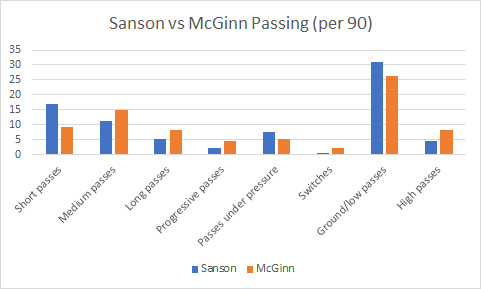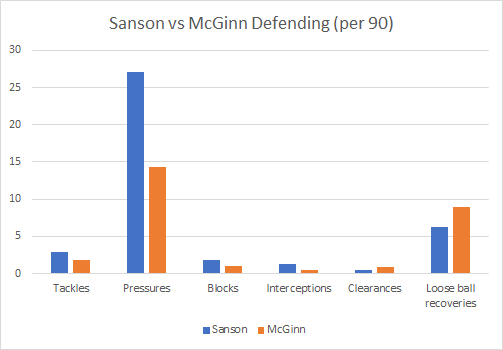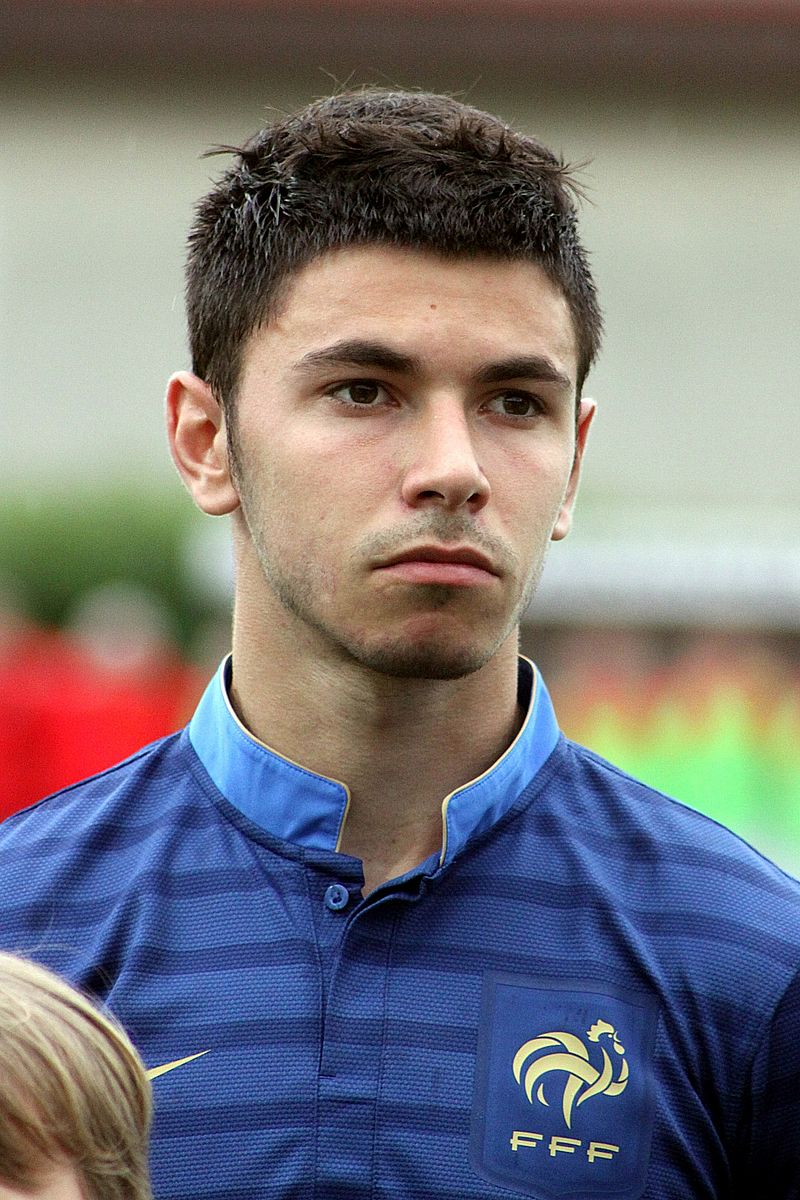Aston Villa are diving back in to the transfer market and are on the verge of making Morgan Sanson their first (and likely only) addition of the January window. Multiple sources are claiming that Villa have agreed a fee with Marseille of an initial £14m for the 26-year-old, and that the move is almost complete. With this transfer, Villa will address a shallow midfield depth chart, providing more competition in an area that needs it.
When you watch Marseille, it’s hard to miss Morgan Sanson. He is a true box-to-box midfielder. When his team are in possession, Sanson roams the pitch from side-line to side-line, always making himself available to receive the ball. In doing so, he shows good spatial awareness as he is able to find pockets of space to occupy or make forward runs to stretch the opposition defence. Sanson is clearly an intelligent player and he doesn’t switch off; his head is constantly moving as he considers where he will go next and what he will do with the ball when it arrives. At Marseille, Dimitri Payet plays on the left wing and tends to cut inside, with Sanson often filling that space with an overlapping outside run. This would translate well at Villa, with Grealish preferring to check in on his right foot rather than go down the line.
Sanson has sufficient but unspectacular technical ability. You see the inconsistency on a game-to-game basis. He will trap the ball with ease most of the time, then out of nowhere it will inexplicably trampoline off his foot. Sanson is capable of dribbling past players, but sometimes he gets by the opponent with pure effort, as he doesn’t always look like he has the ball completely under control. He has good vision and isn’t afraid to try a difficult pass, but the results are mixed. However, Sanson shows quality where it matters; in the final third. He is an above average finisher for his position and has actually scored more goals in his Ligue 1 tenure than he has assisted, with 35 goals and 31 assists across his 219 appearances. In total, he has averaged a goal or an assist every 3.32 games in his career in the French top-flight, which has spanned almost eight years.
Defensively, Sanson is willing and able. He presses aggressively from the front and doesn’t delay in tracking back when the ball does get behind him. Sanson isn’t physically imposing, but he is a nuisance for opposition ball carriers as he pursues them without respite. He also has a knack of arriving at the right time to make a tackle, sensing the opportunity to steal the ball. He doesn’t always execute it well and he commits a fair few fouls, but Sanson certainly has a well-developed defensive mind. He can also hold his own in the air and has good pace for a midfielder, making him a Premier League calibre athlete.
Sanson isn’t a silky, suave player. He’s a 7/10 in most aspects of midfield play with higher marks for intelligence and energy, which isn’t dissimilar to another of Aston Villa’s midfielders…
Jean McGinn?
Indeed, it’s difficult to watch Morgan Sanson without being reminded of John McGinn. Sanson even scored a volley earlier this season that evokes memories of McGinn’s wonder goal against Sheffield Wednesday from 2018. Many of the qualities I have attached to Sanson are reminiscent of Villa’s dynamic Scot and the similarities don’t end there. In terms of WhoScored grade, Sanson’s score for his Ligue 1 career is 6.98, John McGinn’s score? 7.00. Sanson is a mere 2cm taller than McGinn and the pair were born exactly two months apart. However, it may be fools gold to dub Sanson as a John McGinn clone, as when you look beneath the surface, you begin to see their differences.

The first thing to note is that Sanson and McGinn are completely different in the way they pass the ball. As you can see from the table, Sanson plays more short and low passes, whereas McGinn plays more medium, long and high passes, as well as more progressive passes and more switches. Despite playing more difficult passes, McGinn actually has a higher completion percentage overall (77.1% compared to 75.7%) which would indicate that McGinn is a better passer of the ball than Sanson. However, Sanson attempts more passes whilst under pressure, which is likely to influence his accuracy.

Defensively, Sanson is more active than McGinn, recording nearly double the number of pressures as well as totting up more tackles, blocks and interceptions. Sanson also has the edge when it comes to aerial duels, winning 40.9% of his battles compared to 25.7% for McGinn. McGinn beats Sanson in some areas, such as clearances, loose ball recoveries, times dribbled past (1.31 per 90 compared to 2.61 for Sanson) and fouls committed (1 per 90 compared to 1.96). It’s difficult to say which of the two players is the better defender, but Sanson is busier, which counts for a lot.
Elsewhere, McGinn is a better dribbler than Sanson, attempting more dribbles (2.5 to 1.63) and being more successful in doing so (70% to 53.3%). Sanson averages more touches of the ball per 90 (49.1 to 44.8) and is also the target of more passes (45.5 to 34.3).
All of these numbers combine to show that Sanson is the more active player – and I didn’t think it was possible to beat McGinn in that arena – but McGinn has more quality, especially with the ball at his feet. Not to be understated though, is the fact that McGinn had played every single minute of every Villa game before his suspension, whereas Sanson has only played 48.3% of Marseille’s minutes this season. It’s fair to assume that Sanson will be McGinn’s understudy, at least to begin with.
After John McGinn suffered a serious injury in the middle of last season, his absence was severely felt. Dean Smith had no midfield option similar to McGinn in terms of style or quality, and the desperate attempt to replace him with Danny Drinkwater went about as well as expected. I’ve often thought that McGinn is a truly unique player, but in Morgan Sanson, Johan Lange appears to have found someone who at least resembles Super John, and Villa will now have a second player who can fill the ‘number 8’ role in a way that Conor Hourihane never could.
McGinn was once described by club CEO Christian Purslow as “a model signing for Aston Villa” and in Sanson, Dean Smith is getting a player who is of the same mould.
Villa are reported to have been interested in Sanson for 18 months, with the price tag once being thought to be as high as £30m. With Marseille now more willing to sell so that they can use the funds to go after their own targets, the fee is now more realistic and Johan Lange, who’s M.O. is to find value, is jumping at the chance. To be able to sign a player entering the prime of his career, with over seven years of experience (and high-quality performance) in a top five European league, for only £14-15m, is a no-brainer. Dean Smith has said recently that Villa don’t need to add, but won’t turn their nose up at a good deal. To have that freedom in signing players, while so many other teams are struggling with the financial impact of COVID-19, is a true blessing and is all thanks to Villa’s wealthy owners.
If Aston Villa are going to seriously challenge for a place in Europe, now more than ever with a congested fixture list, squad depth will be imperative. The arrival of Morgan Sanson provides them with exactly that.


Well done.
LikeLike